Education & Public Engagement

AUI enhances education through supporting eLearning programs, developing and stewarding collaborative STEM programs, and managing world class scientific facilities.
AUI is a global leader in developing and delivering high-quality workforce development, education and training tools and initiatives. From our inception in 1946, AUI has contributed to the development of a scientifically and technically literate society through education and public outreach. AUI’s educational initiatives span a broad spectrum of ages, professions and disciplines, and pedagogical approaches. At the core of all these initiatives, however, is a deep fidelity to the goal of building the workforce of tomorrow through effective, efficient and innovative projects.
STEM Education & Outreach
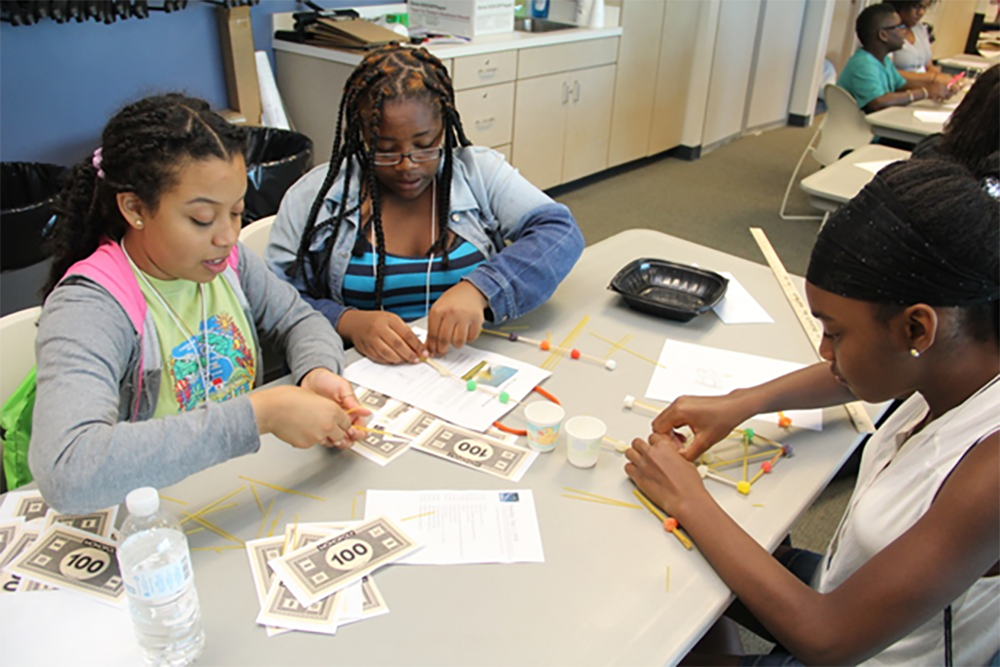
Associated Universities recognizes the importance of cultivating excellence, delivering value, enhancing education and engaging the public. The AUI Office of Education and Public Engagement (OEPE) builds on decades of experience across formal and informal education and outreach, and the management of large complex science projects and facilities. Through the OEPE, AUI works to identify and develop initiatives that are innovative and potentially transformative in STEM related education and outreach.
Capabilities
- Design, develop and coordinate projects and programs that have the potential to significantly improve teaching and learning across STEM related disciplines.
- Collaborate with partners to develop competitive funding proposals for innovative and potentially transformative projects in STEM related education.
- Provide leadership in fiscal and project management and reporting for collaborations with large complex awards.
- Provide high-quality consulting services to organizations (e.g. schools, universities, science centers, etc.) that wish to review and improve the quality of STEM related education programs they provide.
- OEPE continues to actively seek new partners to collaborate with and new sources of funding to expand our portfolio of STEM activities.
Current Programs
ACEAP: Astronomy in Chile Educator Ambassador Program
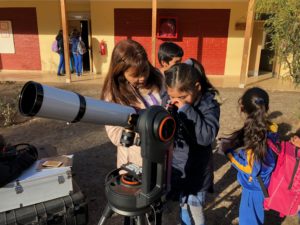 ACEAP brings amateur astronomers, planetarium personnel, and K-16 formal and informal astronomy educators to U.S. astronomy facilities in Chile. While at these facilities, ACEAP ambassadors receive extensive training about the instruments, the science, data products and communicating STEM concepts. When they return home, the ambassadors share their experiences and observatory resources with schools and community groups across the U.S. through a variety of outreach activities, reaching approximately 400,000 people annually. ACEAP is supported by the U.S. National Science Foundation and is a collaboration between Associated Universities Inc. (AUI), Association of Universities for Research in Astronomy (AURA), and the observatories they manage in Chile, including CTIO and Gemini, which are now part of the new NSF’s National Optical-Infrared Astronomy Research Laboratory (NSF’s NOIRLab), and the National Radio Astronomy Observatory and ALMA Observatory, and is supported by the National Science Foundation (NSF 1439408, NSF 1723697, and NSF 2034209).
ACEAP brings amateur astronomers, planetarium personnel, and K-16 formal and informal astronomy educators to U.S. astronomy facilities in Chile. While at these facilities, ACEAP ambassadors receive extensive training about the instruments, the science, data products and communicating STEM concepts. When they return home, the ambassadors share their experiences and observatory resources with schools and community groups across the U.S. through a variety of outreach activities, reaching approximately 400,000 people annually. ACEAP is supported by the U.S. National Science Foundation and is a collaboration between Associated Universities Inc. (AUI), Association of Universities for Research in Astronomy (AURA), and the observatories they manage in Chile, including CTIO and Gemini, which are now part of the new NSF’s National Optical-Infrared Astronomy Research Laboratory (NSF’s NOIRLab), and the National Radio Astronomy Observatory and ALMA Observatory, and is supported by the National Science Foundation (NSF 1439408, NSF 1723697, and NSF 2034209).
Becoming an ACEAP Ambassador: As we move toward a long-term sustainable model to support ACEAP, and in an effort to broaden participation, each ACEAP 10-person cohort includes those supported by NSF grant funding, as well as individuals who are fully supported by their institution and/or personal funds. It is anticipated that five of the ACEAP ambassador positions will be supported by grant funding and the remaining five will be fully supported via institutional and/or personal funding. PLEASE NOTE: Regardless of the source of an ambassador’s support, requirements remain the same, and all ambassadors will receive the $500 stipend for completion of their seven required outreach activities.
ASTRO ACCEL
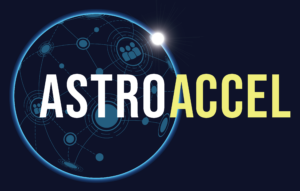 The night sky has captured our imagination and inspired humans across the globes since the dawn of our existence. Today, astronomy is seen by many as a gateway to inspiring interest and learning in students and the general public and has demonstrated its ability to engage people across cultures and political borders. The Global Network for Accelerating Synergies Through Research On Astronomy Culture, Communication, Education and Learning (ASTRO ACCEL) is a new initiative working to build an international network of networks (NoN) to accelerate research and research to practice in astronomy education, engagement/outreach, communications and culture. The 3-year, $1.6M project has initially engaged 13 networks across six continents to explore and develop tools and techniques and build the human infrastructure necessary for a vibrant and sustainable NoN. As the project evolves, we will engage additional research and practitioner network partner institutions and individuals. ASTRO ACCEL is funded by the U.S. National Science Foundation’s Office of International Science & Engineering (Award # 2301922).
The night sky has captured our imagination and inspired humans across the globes since the dawn of our existence. Today, astronomy is seen by many as a gateway to inspiring interest and learning in students and the general public and has demonstrated its ability to engage people across cultures and political borders. The Global Network for Accelerating Synergies Through Research On Astronomy Culture, Communication, Education and Learning (ASTRO ACCEL) is a new initiative working to build an international network of networks (NoN) to accelerate research and research to practice in astronomy education, engagement/outreach, communications and culture. The 3-year, $1.6M project has initially engaged 13 networks across six continents to explore and develop tools and techniques and build the human infrastructure necessary for a vibrant and sustainable NoN. As the project evolves, we will engage additional research and practitioner network partner institutions and individuals. ASTRO ACCEL is funded by the U.S. National Science Foundation’s Office of International Science & Engineering (Award # 2301922).
Strategic Objectives: In the areas of astronomy education, engagement/outreach, culture and communication, ASTRO ACCEL will:
- Accelerate research.
- Grow relationships between and among researchers and practitioners.
- Build additional human capacity and infrastructure needed to support an international network of networks of individuals and institutions.
AUI-Astronomers Without Borders Partnership
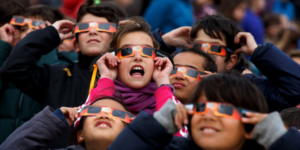 Both Astronomers Without Borders (AWB) and AUI recognize that astronomy is an effective tool to engage the public in science and engineering and to introduce students to STEM fields. AWB and AUI are working together to connect people worldwide through various aspects of astronomy, particularly in public outreach and education. Most recently, AWB and AUI are working together to disseminate eclipse glasses and educational resources globally to benefit children and educators most in need.
Both Astronomers Without Borders (AWB) and AUI recognize that astronomy is an effective tool to engage the public in science and engineering and to introduce students to STEM fields. AWB and AUI are working together to connect people worldwide through various aspects of astronomy, particularly in public outreach and education. Most recently, AWB and AUI are working together to disseminate eclipse glasses and educational resources globally to benefit children and educators most in need.
Big Astronomy: People, Places, Discoveries
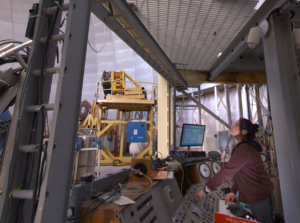 Big Astronomy informs learners of all ages about STEM careers at major observatories in Chile and incorporates extended learning beyond the planetarium show. The project aims to deepen STEM identity and to offer multiple entry points for engagement through in person, online and hands-on experiences. Astronomy looks very different than what many imagine—the white-haired man peering through a telescope. The Big Astronomy – People, Places, Discoveries planetarium show highlights the diverse team and jobs necessary to operate the world’s largest observatories. Audiences walk away seeing how their own passions, from tinkering to cooking, could contribute to astronomy’s big discoveries—and come realize that scientists look like them. In addition, the project leverages numerous synergistic channels to increase community engagement. The free bilingual (Spanish and English) planetarium show is available to planetariums, or via 360 streaming, or HD flat screen download. Live events with people who work in the observatories highlight their paths to astronomy, the details of their job and their other hobbies. Planetariums work with astronomy clubs and museums to support the message that astronomy is for everyone. Hands-on and virtual activities are used in public engagement settings, are available to download in both Spanish and English, and designed for both hemispheres.
Big Astronomy informs learners of all ages about STEM careers at major observatories in Chile and incorporates extended learning beyond the planetarium show. The project aims to deepen STEM identity and to offer multiple entry points for engagement through in person, online and hands-on experiences. Astronomy looks very different than what many imagine—the white-haired man peering through a telescope. The Big Astronomy – People, Places, Discoveries planetarium show highlights the diverse team and jobs necessary to operate the world’s largest observatories. Audiences walk away seeing how their own passions, from tinkering to cooking, could contribute to astronomy’s big discoveries—and come realize that scientists look like them. In addition, the project leverages numerous synergistic channels to increase community engagement. The free bilingual (Spanish and English) planetarium show is available to planetariums, or via 360 streaming, or HD flat screen download. Live events with people who work in the observatories highlight their paths to astronomy, the details of their job and their other hobbies. Planetariums work with astronomy clubs and museums to support the message that astronomy is for everyone. Hands-on and virtual activities are used in public engagement settings, are available to download in both Spanish and English, and designed for both hemispheres.
Global Survey of Accessibility Resources
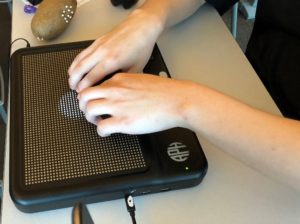
Innovators Developing Accessible Tools for Astronomy (IDATA) students use a dynamic multilevel tactile touch display to experience a solar eclipse. This type of advanced technology can help make learning more accessible for all children. (Spuck/AUI/NSF – 2019)
The Department of Social Inclusion of the Secretariat for Access to Rights and Equity of the Organization of American States, and Associated Universities Inc. (AUI) have initiated a joint project to create an online repository of existing resources that make teaching and learning more accessible for persons with disabilities. AUI and the OAS believe inclusive education is a matter of Human Rights that requires a substantial social and political effort to make schools and other learning spaces, a place of equal opportunity, where children and youth with disabilities have a presence and participation; where universal accessibility and individual learning processes can be recognized and valued as well as the realities of life, culture, languages and identities of all students. With our commitment to establish an online accessible repository to share practices, policies, knowledge, and resources and tools, we can reduce the persistent educational gap that negatively impacts the lives of persons with disabilities and other groups in situations of vulnerability, and contribute to building a more inclusive society for all.
We are asking for your help to conduct an initial survey to identify programs and resources that make teaching and learning more accessible for persons with disabilities. We invite you to take part in this brief survey yourself, and to share the survey broadly with others you know.
IDATA: Innovators Developing Accessible Tools for Astronomy
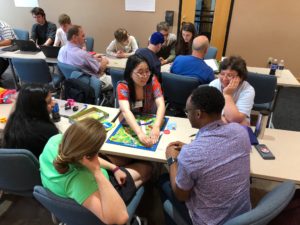 Innovators Developing Accessible Tools for Astronomy (IDATA) is a project that works to advance knowledge of best practices in teaching and learning related to computation and computational thinking in astronomy. The project aims to understand how participation influences students’ attitudes and beliefs about who can engage in STEM and computing. The project brings together blind and visually impaired (BVI) and sighted high school and middle school students and their teachers to create a fully accessible astronomy data retrieval and analysis software tool. The IDATA team utilizes user-centered design processes and the iterative method for the development and testing of software and the modules—improving access to our amazing universe for those with BVI related disabilities. AUI partners with TERC – STEM Education Evaluation Center, Geneva Lakes Astrophysics and STEAM, Linder Research and Development Inc., University of North Carolina – Chapel Hill, University of Nevada – Las Vegas, and others to make IDATA possible. IDATA is supported by the U.S. National Science Foundation.
Innovators Developing Accessible Tools for Astronomy (IDATA) is a project that works to advance knowledge of best practices in teaching and learning related to computation and computational thinking in astronomy. The project aims to understand how participation influences students’ attitudes and beliefs about who can engage in STEM and computing. The project brings together blind and visually impaired (BVI) and sighted high school and middle school students and their teachers to create a fully accessible astronomy data retrieval and analysis software tool. The IDATA team utilizes user-centered design processes and the iterative method for the development and testing of software and the modules—improving access to our amazing universe for those with BVI related disabilities. AUI partners with TERC – STEM Education Evaluation Center, Geneva Lakes Astrophysics and STEAM, Linder Research and Development Inc., University of North Carolina – Chapel Hill, University of Nevada – Las Vegas, and others to make IDATA possible. IDATA is supported by the U.S. National Science Foundation.
Mission Patagonia
 Mission Patagonia offers a unique experience to one of the most remote regions of the planet. Participants in the program will travel to the Melimoyu Elemental Reserve in northern Patagonia, Chile. The Reserve is a pristine natural laboratory, surrounded by volcanoes, ice, fjords, cetaceans, blue whales and other unique resources. While on the 10-day expedition, participants will investigate innovative approaches to effective conservation and climate change mitigation and share their experience with networks back home. In addition, several virtual meetings and trainings will be held prior to the expedition in Chile. Mission Patatgonia a collaboration between the MERI Foundation and Associated Universities Inc. (AUI).
Mission Patagonia offers a unique experience to one of the most remote regions of the planet. Participants in the program will travel to the Melimoyu Elemental Reserve in northern Patagonia, Chile. The Reserve is a pristine natural laboratory, surrounded by volcanoes, ice, fjords, cetaceans, blue whales and other unique resources. While on the 10-day expedition, participants will investigate innovative approaches to effective conservation and climate change mitigation and share their experience with networks back home. In addition, several virtual meetings and trainings will be held prior to the expedition in Chile. Mission Patatgonia a collaboration between the MERI Foundation and Associated Universities Inc. (AUI).
NA-ROAD: North American Regional Office of Astronomy for Development
 The Office of Astronomy for Development (OAD) is an initiative of the International Astronomical Union (IAU) using the power and excitement of astronomy to promote economic, societal and human development. “The mission of the OAD is to help further the use of astronomy, including its practitioners, skills and infrastructures, as a tool for development by mobilizing the human and financial resources necessary in order to realize the field’s scientific, technological and cultural benefits to society.”
The Office of Astronomy for Development (OAD) is an initiative of the International Astronomical Union (IAU) using the power and excitement of astronomy to promote economic, societal and human development. “The mission of the OAD is to help further the use of astronomy, including its practitioners, skills and infrastructures, as a tool for development by mobilizing the human and financial resources necessary in order to realize the field’s scientific, technological and cultural benefits to society.”
The North American Regional Office of Astronomy for Development (NA-ROAD) is a collaboration of the International Astronomical Union, Adler Planetarium, Associated Universities Inc. (AUI) and Association of Universities for Research in Astronomy (AURA). For additional information, please contact the NA-ROAD at [email protected].
NEREID: Network for Earth-Space Research Education and Innovation with Data
 Currently, the world creates more than 2.5 quintillion bytes of data daily, and a large portion of this data is in the Earth-space sciences domain. This massive influx of data is fundamentally changing existing methods of experimental design, and the skills required to do this new kind of research are increasingly needed. NEREID advances research and innovation through research, education and engagement with big data in earth-space sciences. This growing network representing academia, industry, nonprofits and government organizations will: (1) explore the challenges of big data in earth-space science, and implement solutions across learning, (2) build an interdisciplinary community of practice in earth-space data science learning, (3) develop and disseminate research-based best practices and curricular resources in teaching and learning with earth-space data, and (4) bring together industry, academia and policy makers to build and grow a data literate workforce and society.
Currently, the world creates more than 2.5 quintillion bytes of data daily, and a large portion of this data is in the Earth-space sciences domain. This massive influx of data is fundamentally changing existing methods of experimental design, and the skills required to do this new kind of research are increasingly needed. NEREID advances research and innovation through research, education and engagement with big data in earth-space sciences. This growing network representing academia, industry, nonprofits and government organizations will: (1) explore the challenges of big data in earth-space science, and implement solutions across learning, (2) build an interdisciplinary community of practice in earth-space data science learning, (3) develop and disseminate research-based best practices and curricular resources in teaching and learning with earth-space data, and (4) bring together industry, academia and policy makers to build and grow a data literate workforce and society.
AUI-NSBP Partnership
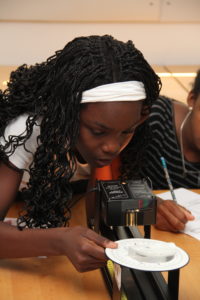 AUI partners with the National Society of Black Physicists (NSBP) to design and implement various programs. Examples include the NSBP Annual Conference, Physicists Inspiring the Next Generation (PING): Exploring the Cosmos with NRAO, and the National Astronomy Consortium (NAC). AUI’s role in its partnership with the NSBP varies with each initiative. In some cases, personnel from AUI or our facilities collaborate with the NSBP on the design and implementation of the programs themselves. In other cases, AUI works collaboratively with the NSBP to submit funding proposals to secure the necessary resources for projects.
AUI partners with the National Society of Black Physicists (NSBP) to design and implement various programs. Examples include the NSBP Annual Conference, Physicists Inspiring the Next Generation (PING): Exploring the Cosmos with NRAO, and the National Astronomy Consortium (NAC). AUI’s role in its partnership with the NSBP varies with each initiative. In some cases, personnel from AUI or our facilities collaborate with the NSBP on the design and implementation of the programs themselves. In other cases, AUI works collaboratively with the NSBP to submit funding proposals to secure the necessary resources for projects.
Radio Astronomy Observing Program
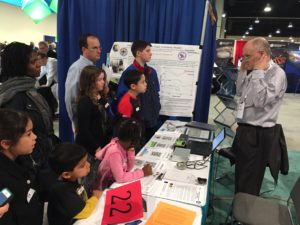 The Radio Astronomy Observing Program (RAOP) is a collaboration between the Astronomical League (AL), AUI and its facilities. There are many parts of the electromagnetic spectrum that our eyes are not able to observe, but with a different type of sensor we can observe in an entirely different realm, that of the radio spectrum. This program is designed to introduce and encourage the construction and operation of radio telescopes or other detectors. RAOP includes five types of observing that can be done with various types of radio equipment, which will introduce learners of all ages to a variety of Earth, space, physics, and engineering concepts, practices and processes.
The Radio Astronomy Observing Program (RAOP) is a collaboration between the Astronomical League (AL), AUI and its facilities. There are many parts of the electromagnetic spectrum that our eyes are not able to observe, but with a different type of sensor we can observe in an entirely different realm, that of the radio spectrum. This program is designed to introduce and encourage the construction and operation of radio telescopes or other detectors. RAOP includes five types of observing that can be done with various types of radio equipment, which will introduce learners of all ages to a variety of Earth, space, physics, and engineering concepts, practices and processes.
STEM Attitude, Self-Efficacy, and Career-Intention Gains with Robotic Telescope-based Observing Experiences for Introductory Astronomy Students
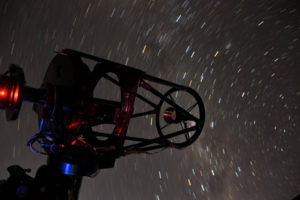 Using scientific instruments to make discoveries and solve problems in STEM classrooms enables undergraduates to experience how professional scientists actually work. Such experiences increase students’ engagement, learning and excitement about science. In many disciplines, instructors have redesigned courses to embed authentic research experiences. The project is following up on previous work by conducting a large-scale case study that involves approximately 19,000 students at 35 institutions. This research will measure changes in students’ attitudes toward science, confidence in their abilities, conceptual understanding, and career intentions in both traditional and Skynet-based introductory astronomy courses. The research will include further development and assessment of student-outcome metrics that are specific to astronomy. To support this research, the investigators will also provide professional development to help approximately 40 astronomy instructors from the participating institutions learn how to incorporate Skynet-based activities into their courses and will update the curriculum and its supporting technologies.
Using scientific instruments to make discoveries and solve problems in STEM classrooms enables undergraduates to experience how professional scientists actually work. Such experiences increase students’ engagement, learning and excitement about science. In many disciplines, instructors have redesigned courses to embed authentic research experiences. The project is following up on previous work by conducting a large-scale case study that involves approximately 19,000 students at 35 institutions. This research will measure changes in students’ attitudes toward science, confidence in their abilities, conceptual understanding, and career intentions in both traditional and Skynet-based introductory astronomy courses. The research will include further development and assessment of student-outcome metrics that are specific to astronomy. To support this research, the investigators will also provide professional development to help approximately 40 astronomy instructors from the participating institutions learn how to incorporate Skynet-based activities into their courses and will update the curriculum and its supporting technologies.
For more information or to become one of the participating astronomy instructors, please email [email protected].
STEM Storytelling through Podcasts
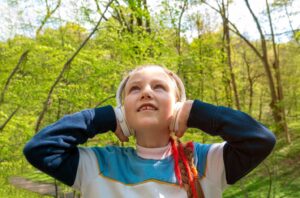 Research has shown that students who are blind or have low vision (BLV) face many obstacles in pursuing educational pathways to STEM fields beginning in early education. This project engages BLV and sighted students in the use and development of podcasts to promote STEM learning and career awareness. The curriculum serves as a foundation for educators to integrate podcasts and podcast technology into the classroom in a way that is accessible for BVI students.
Research has shown that students who are blind or have low vision (BLV) face many obstacles in pursuing educational pathways to STEM fields beginning in early education. This project engages BLV and sighted students in the use and development of podcasts to promote STEM learning and career awareness. The curriculum serves as a foundation for educators to integrate podcasts and podcast technology into the classroom in a way that is accessible for BVI students.
Tumble, in partnership with AUI, is producing a variety of podcast episodes featuring scientists who are blind or have low vision. Teachers will guide students in using these episodes as the basis for producing their own science podcasts—developing ideas, interviewing scientists, writing scripts and editing audio. The final materials will be freely available in a web portal, where students and teachers around the world can access it. Tumble’s episodes will also be freely available and will reach its estimated 200,000 listeners worldwide. Additionally, the episodes will be adapted into Spanish, and released on Tumble’s Spanish-language podcast feed.
This project is funded by the U.S. National Science Foundation’s (NSF) Innovative Technology Experiences for Students and Teachers (ITEST) program, which supports projects that build understandings of practices, program elements, contexts and processes contributing to increasing students’ knowledge and interest in science, technology, engineering, and mathematics (STEM) and information and communication technology (ICT) careers.
STEM Education Incubator
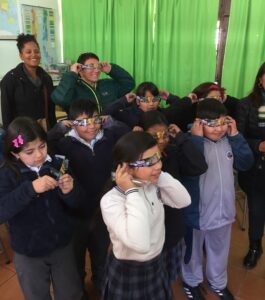 Individuals and smaller organizations often have great ideas but can lack the experience to develop competitive funding proposals, or the expertise on staff to deal with complicated financial rules associated with managing large awards. The STEM Education Incubator (SEI) brings together AUI’s expertise in education, fund development and fiscal management to create an “umbrella” initiative under which individuals, organizations and teams can successfully develop and manage innovative projects in the STEM landscape. Do you have a great idea to improve STEM education but lack fund development experience or resources to manage a large award? SEI may be what you’re looking for!
Individuals and smaller organizations often have great ideas but can lack the experience to develop competitive funding proposals, or the expertise on staff to deal with complicated financial rules associated with managing large awards. The STEM Education Incubator (SEI) brings together AUI’s expertise in education, fund development and fiscal management to create an “umbrella” initiative under which individuals, organizations and teams can successfully develop and manage innovative projects in the STEM landscape. Do you have a great idea to improve STEM education but lack fund development experience or resources to manage a large award? SEI may be what you’re looking for!
For more information, please email [email protected].
